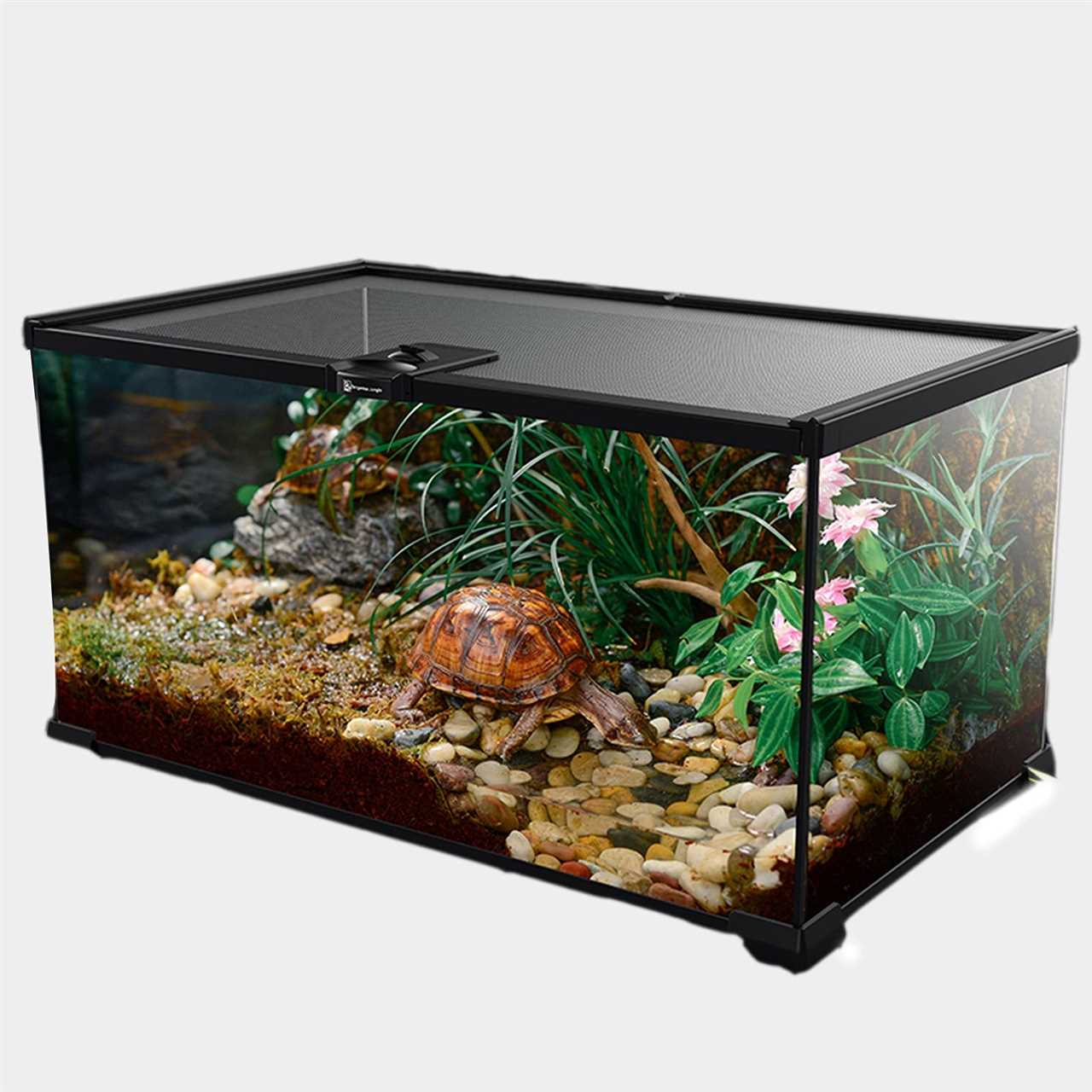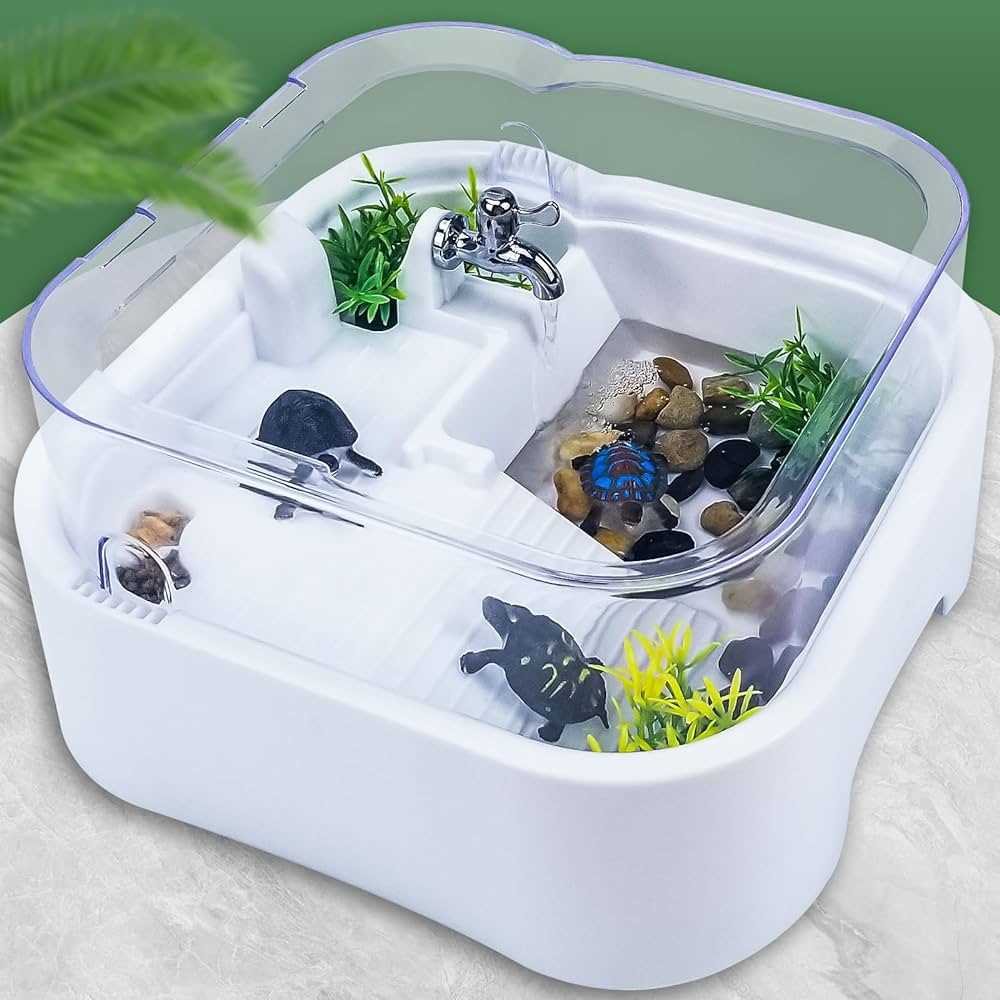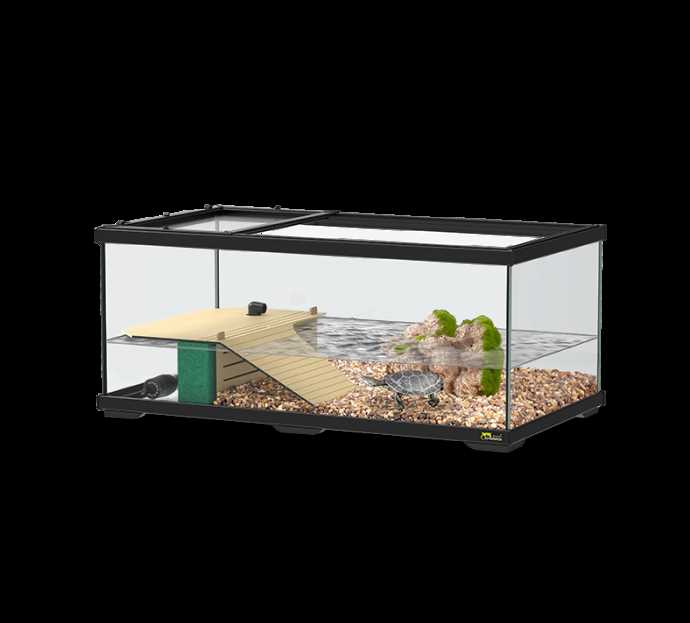
1. Size and Space: The size of your terrarium should be proportional to the number and size of your turtles. As a general rule, each turtle requires at least 10 gallons of space, with an additional 5 gallons for each additional turtle. Ensure that your terrarium is spacious enough for your turtles to swim, climb, bask, and explore comfortably.
2. Temperature and Lighting: Turtles are ectothermic creatures, meaning they rely on external sources to regulate their body temperature. To create the perfect environment, provide a temperature gradient within the terrarium, with basking spots reaching around 95°F (35°C) and the water temperature around 75°F (24°C). Use heat lamps and UVB lights to mimic the natural sunlight, which is essential for their overall health and shell development.
5. Diet and Feeding: Ensure that your turtles receive a varied and nutritionally balanced diet. Offer a combination of commercial turtle pellets, fresh vegetables, and live or frozen prey, such as insects or small fish. Remember to adjust the portion sizes based on the size and age of your turtles and remove any uneaten food to maintain water quality.
By following these expert tips and guidelines, you can create a perfect terrarium for your turtles, providing them with a safe and comfortable habitat that meets their specific needs. Remember to perform regular maintenance and observe the behavior and health of your turtles to ensure they are thriving in their new home. Your dedicated care and attention will result in happy and healthy turtles for years to come.
Why Choose a Terrarium for Your Turtle: Benefits and Advantages
A terrarium is a specially designed enclosure that provides a controlled environment for your turtle to thrive. Choosing a terrarium for your turtle comes with several benefits and advantages that can contribute to its overall health and well-being.
1. Suitable Habitat
A terrarium provides a suitable habitat for your turtle, mimicking its natural environment. It allows you to recreate the ideal temperature, lighting, and humidity levels that are essential for your turtle’s survival.
2. Safety and Security
With a terrarium, you can ensure the safety and security of your turtle. It eliminates the risk of predators and provides a confined space where your turtle can explore without the fear of escaping or encountering any potential dangers.
3. Easy Monitoring and Control
A terrarium allows for easy monitoring and control of your turtle’s environment. You can adjust the temperature, lighting, and humidity levels as needed to create the perfect conditions for your turtle’s overall health and comfort.
4. Easy Maintenance
Keeping a terrarium clean and maintaining its hygiene is much easier compared to other types of enclosures. It provides a controlled and contained environment, making it simpler to clean and remove any waste materials efficiently.
5. Decoration and Aesthetics
A terrarium offers the opportunity for creative decoration and aesthetics. You can incorporate various natural elements, such as plants, rocks, and logs, to create a visually appealing habitat that enhances your turtle’s living space.
6. Reduced Risk of Disease
A properly maintained terrarium reduces the risk of disease and infection for your turtle. By controlling the environment, you can ensure proper hygiene and minimize the exposure to harmful bacteria or parasites that can jeopardize your turtle’s health.
Conclusion
Choosing a terrarium for your turtle provides numerous benefits and advantages. It creates a suitable habitat, ensures safety and security, allows for easy monitoring and control, simplifies maintenance, offers decorative options, and reduces the risk of disease. Investing in a terrarium is a wise decision for any turtle owner, as it promotes the overall well-being and longevity of your beloved pet.
Essential Components for a Healthy Terrarium Environment

1. Substrate:
2. Water Source:
Turtles require a constant source of clean, fresh water for drinking and swimming. Depending on the species of turtle, you may need to provide a shallow water dish or a larger aquatic area. The water should be regularly cleaned and filtered to maintain optimal hygiene for your turtle.
3. Basking Spot:
Turtles are ectothermic animals, meaning they rely on external sources of heat to regulate their body temperature. Therefore, providing a basking spot is crucial in their terrarium. This can be achieved through the use of a heat lamp or a basking platform. The basking spot should have a temperature range of 85-95°F to allow the turtle to thermoregulate.
4. UVB Lighting:
5. Hiding Spots:
Turtles need access to hiding spots to feel secure and reduce stress. Hiding spots can be created using various materials such as logs, rocks, or caves. These hiding spots should be positioned in both the water and land areas of the terrarium to accommodate the turtle’s natural behavior.
6. Temperature and Humidity Gauges:
Monitoring the temperature and humidity levels in your turtle’s terrarium is essential for their overall health. This can be achieved by installing thermometers and hygrometers in the terrarium. The temperature should be kept within the appropriate range for the species of turtle, while humidity levels should be maintained according to their natural habitat requirements.
By incorporating these essential components into your turtle’s terrarium, you are providing them with a healthy and enriched environment. Remember to regularly clean and maintain the terrarium to ensure the overall well-being of your turtle.
Proper Heating and Lighting for Your Turtle’s Terrarium
When creating a terrarium for turtles, it is essential to provide proper heating and lighting to ensure their health and well-being. Turtles are ectothermic animals, which means they rely on external sources for regulating their body temperature. Therefore, it is crucial to set up a terrarium that mimics their natural habitat and provides the necessary heat and light for their overall development.
Temperature Requirements

Turtles require a specific temperature range in their terrarium to maintain their metabolic functions, digestion, and overall activity levels. The ideal temperature range for most turtle species is between 75-85 degrees Fahrenheit (24-29 degrees Celsius) during the day and a slightly lower temperature at night. To achieve this, it is recommended to use a combination of basking lights and heat lamps.
The basking light should be situated at one end of the terrarium and provide a focused heat spot, allowing turtles to regulate their body temperature by basking. The other end of the terrarium should have a cooler area for the turtles to retreat when they want to cool down.
Lighting Requirements

Proper lighting is crucial for the well-being of turtles in a terrarium. Turtles need access to ultraviolet (UV) light to synthesize vitamin D3, which aids in the absorption of calcium and prevents metabolic bone disease.
It is recommended to use a UVB lamp specifically designed for reptiles. This lamp should be placed within the terrarium, providing a UVB exposure of about 10-12 hours per day. Ensure that the lamp is placed within the recommended distance from the turtles to ensure they receive the optimal UVB exposure.
Light Cycle
Turtles also require a consistent light cycle to simulate natural daylight patterns. It is recommended to use a timer to regulate the light cycle, mimicking the natural rhythm of the sun. A light cycle of 12-14 hours of light followed by 10-12 hours of darkness is suitable for most turtle species.
By providing the appropriate heating and lighting conditions in your turtle’s terrarium, you can help maintain their health, promote their natural behaviors, and support their overall well-being.
Choosing the Right Substrate for Your Turtle’s Terrarium
In addition to being safe, the substrate should also provide good drainage. Turtles require a moist environment, but stagnant water can lead to health issues such as shell rot and bacterial infections. Choose a substrate that allows excess water to drain effectively, preventing any standing water.
The substrate should also be able to retain moisture to create a humid environment. Turtles need a certain level of humidity for healthy respiratory function and proper shell growth. Coconut coir and sphagnum moss are excellent choices for retaining moisture and maintaining the required humidity levels.
Another consideration when choosing the substrate is the texture. Turtles love to dig and burrow, so a substrate with a loose and sandy texture will provide them with the opportunity to exhibit natural behaviors. Choose a substrate that is easy to dig into and does not pack down too tightly.
It is also important to consider the ease of cleaning and maintenance when selecting the substrate. Some substrates can be difficult to clean and may require frequent replacement. Look for a substrate that is easy to spot clean and can be refreshed without completely changing the entire terrarium.
Lastly, consider the aesthetic appeal of the substrate. While this may not be a high priority for the turtles themselves, choosing a substrate that looks natural and visually appealing will enhance the overall look of the terrarium. Consider using a mix of different substrates to create a more varied and interesting environment for your turtles.
| Safe Substrates | Avoid |
|---|---|
| Coconut Coir | Pine or Cedar Shavings |
| Sphagnum Moss | Play Sands |
| Cypress Mulch | Gravel |
Nutrition and Feeding Guidelines for Turtles in a Terrarium
One of the most important components of a turtle’s diet is leafy greens. These include vegetables like kale, spinach, and collard greens. These greens are rich in essential vitamins and minerals that turtles need to stay healthy. It is recommended to offer a variety of greens to ensure a well-rounded diet.
In addition to leafy greens, turtles also require protein in the form of insects or commercial turtle pellets. Insects like crickets, mealworms, and earthworms can be offered as occasional treats to provide the necessary protein. Commercial turtle pellets can be found at pet stores and are formulated to meet the specific dietary needs of turtles.
Another important aspect of turtle nutrition is providing them with calcium and Vitamin D3. These nutrients are needed for healthy shell and bone development. Calcium can be offered in the form of cuttlebone, which turtles can chew on. Exposing turtles to natural sunlight or providing them with a UVB lamp is essential for Vitamin D3 synthesis.
| Food | Frequency |
|---|---|
| Leafy greens (kale, spinach, collard greens) | Everyday |
| Insects (crickets, mealworms, earthworms) | 2-3 times a week |
| Commercial turtle pellets | 2-3 times a week |
By following these nutrition and feeding guidelines, you can ensure that your turtle has a healthy and balanced diet while living in a terrarium.
Maintenance and Cleaning Tips for Your Turtle’s Terrarium
Maintaining a clean and healthy terrarium environment is essential for the well-being of your turtles. Regular maintenance and cleaning routines are necessary to ensure that your turtles have a safe and comfortable living space. Here are some helpful tips to keep your turtle’s terrarium in top condition:
| 1. Regular water changes: | |
| 2. Filter maintenance: | Invest in a quality water filter system to keep the water clean and clear. Clean the filter regularly according to the manufacturer’s instructions to ensure its efficiency. A clean filter helps remove debris and maintain water quality. |
| 3. Removing waste: | |
| 4. Terrarium cleaning: | On a regular basis, thoroughly clean the terrarium. Remove all decorations, rocks, and substrate from the terrarium and scrub them with a mild soap or reptile-safe cleaner. Rinse everything thoroughly before placing it back in the terrarium. |
| 5. UVB bulb replacement: | |
| 6. Regular monitoring: | Keep an eye on your turtle’s behavior, eating habits, and overall health. Regular monitoring can help you detect any potential issues early on and seek proper treatment or adjustments to their terrarium environment. |
| 7. Consult with a veterinarian: | If you have any concerns about the maintenance or cleanliness of your turtle’s terrarium, consult with a reptile veterinarian. They can provide expert advice specific to your turtle’s needs and help you create a proper maintenance routine. |
By following these maintenance and cleaning tips, you can ensure that your turtle’s terrarium remains a healthy and comfortable habitat for them to thrive in. Remember to always prioritize the well-being of your turtles and provide them with a clean and well-maintained environment.

I’m Lena Adams—a product of an unconventional upbringing in the African wilderness. My father, a daring explorer of African wildlife, sparked my fascination with reptiles, a passion that intertwined with the tragic loss of my mother during an expedition, leaving an indelible mark on my life. Driven to understand the creatures that captivated my parents, I embarked on my journey, sharing insights about reptiles, frogs, and lizards on my website. Through my explorations and conservation efforts, I honour my family’s legacy while seeking connections—to the creatures, nature, and the mother whose presence I yearn to understand.
